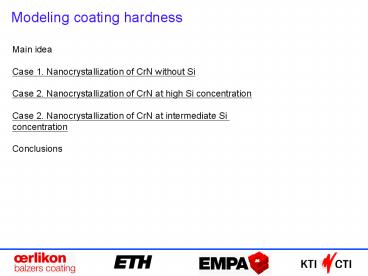Main idea - PowerPoint PPT Presentation
1 / 12
Title:
Main idea
Description:
Main idea Case 1. Nanocrystallization of CrN without Si Case 2. Nanocrystallization of CrN at high Si concentration Case 2. Nanocrystallization of CrN at intermediate Si – PowerPoint PPT presentation
Number of Views:61
Avg rating:3.0/5.0
Title: Main idea
1
Main idea Case 1. Nanocrystallization of CrN
without Si Case 2. Nanocrystallization of CrN at
high Si concentration Case 2. Nanocrystallization
of CrN at intermediate Si concentration Conclus
ions
2
Main idea. Hardness of coating satisfies
Hall-Petch equation
(1)
?0 is hardness of CrN single crystal. Si
addition leads to decrease of grain size and
hardness increase. Further decrease of CrN grain
size leads to hardness decrease inversed
Hall-Petch effect, modified Hall-Petch equation
R is Burgers vector of dislocation localized in
nanocrystal
(1')
r0 2a10a, where a is lattice constant of cubic
CrN. We consider three limiting cases of
nanocrystallization to show why this hardness
increase takes place. (a, k, d, r, ?0 could be
measured, k - fitness parameter)
3
- Case 1. Nanocrystallization of CrN without Si
- - Random walk of Cr atom along the substrate.
- - What time is necessary to meet another Cr atom
and arrange - CrN nanocrystal in N2 atmosphere?
- - After time t Cr atom can be found at the
distance - from initial point (D - diffusion coefficient
of Cr atom) - - Surface density of Cr atoms is
- - Surface density is also equal to ?t, where ? is
proportional to - deposition rate ?? ?? ?/a3 (a is lattice
constant) - After meeting two Cr atoms do not move.
Connected together, - they wait for next Cr atom to arrange
nanocrystal - Distance between nanocrystals (or grain size) is
of about - (2)
4
- Case 2. Nanocrystallization of CrN at high Si
concentration - All CrN nanocrystals are surrounded by Si atoms
- Walking along substrate, Si atom meets CrN
nanocrystal and - takes position on CrN nanocrystal boundary, Si
is rejected from - coming inside CrN nanocrystal bulk
- When CrN nanocrystal becomes surrounded by Si
atoms (or - by monoatomic Si3N4 film), CrN nanocrystal
growth completes - - Number of Cr atoms in CrN nanocrystals
- Number of Si atoms in Si3N4 monolayer film
around CrN - nanocrystal . Thus
- (3)
5
Case 2. Nanocrystallization of CrN at high Si
concentration
(2) Result of crystallization depends on
which distance is shorter (2) or (3) (3)
Equation (3) wins in case of large Si density
(4)
6
Case 2. Nanocrystallization of CrN at high Si
concentration Hardness of n-CrN/a-Si3N4 coating
can be estimated via Hall-Petch equation (1) as
(5)
or via improved Hall-Petch equation (1) as
(5)
7
- Case 3. Nanocrystallization of CrN at
intermediate Si concentration - Number of atoms at boundary of CrN nanocrystal
is 4d/a - Amount of Si atoms on boundary of CrN
nanocrystal is ??d2/a2 - (? nSi/nCr).
- - Thus, mean rate of CrN nanocrystal growth is
- Here non-dimensional parameter ??1 included to
take into - account non-uniform character of CrN
nanocrystal growth
8
Case 3. Nanocrystallization of CrN at
intermediate Si concentrations If is the
CrN nanocrystal size in the absence of Si Atoms
(Eg. (2)), we can write
Therefore
(6)
At large Si concentrations (?d0 gtgt4a) Eq. (6)
transforms into Eq. (3). To estimate hardness,
Eq. (6) should be substituted into Eq. (1) and
Eq. (1)
9
Simulated using Eq. (6) Experimental curve
from our October interim report is used to
estimate ?d0 32
Typical dependence of nanocrystal size on Si
concentration (Equation (6)). Assumed a 0.6 nm,
?d0 32 nm
10
Simulated using Eq. (1) Our experimental
data (e.g. from October interim report) can be
used for estimation of parameters of equation (1)
Typical dependence of hardness on Si
concentrations. Assumed ?0 15 GPa, k 10 Gpa
nm1/2 , r0 3a
11
Conclusions 1. Size of CrN nanocrystals is
independent of deposition rate. Even in Case
1 this dependence is very week 2. Size of CrN
nanocrystals depends on temperature at low Si
concentrations (Case 2) due to temperature
dependence of diffusion coefficient D, which
has activation barrier character, but
independent on temperature at high Si
concentrations (Case 2) 3. Size of CrN
nanocrystals is inversely proportional to Si
concentration (Eq. (3)) 4. Decrease of n-CrN/a-Si
N coating hardness at large Si concentrations
could be result of inverse Hall-Petch effect.
Hardness is proportional to square root of Si
concentration.
12
How can we describe (simulate) preferred
crystallites orientation? Phase-field method for
simulation of microstructural patterns (PVD film
growth ?) M. Plapp, Ecole Polytechnique,
Palaiseau
J. Crystal Growth, in press
Evolution of cellular patterns for different
anisotropies.































